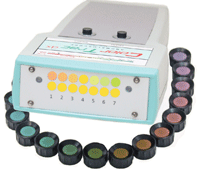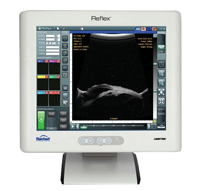Color Vision Testing
Anomaloscope
You may have used color vision testing to detect color blindness before, but have you ever used it to diagnose and monitor other clinical eye conditions? Many diseases—such as diabetes, glaucoma, optic neuritis, age-related macular degeneration and cataracts—cause minute changes in color vision.

By recognizing these tiny shifts in color sensitivity, the ColorTrac anomaloscope can help clinicians detect early eye disease, monitor changes over time and manage disease for functional improvement, the manufacturer says. This portable, one-pound device can be easily toted from one exam room to another and used at health fairs and screenings. It doesn’t require any special training and is reimbursable through Medicare, the company says.
ColorTrac shows the patient an array of seven match points simultaneously; and the patient is asked to select the vertical pair that is the closest color match. The match-range is centered on the normal point, and is segmented into increments of just noticeable differences, which allow positive, accurate responses in less than 60 seconds, the company says.
Visit www.colortracdx.com.
Color Blindness Test App
With a new app from EnChroma Inc., adults and children can now take a free color blindness test on their smartphone or tablet.
The test presents a series of simple geometric shapes—a circle, square or diamond—each camouflaged by a random pattern of dots of varying size and brightness. The color of the dots is the only visual cue that allows users to identify the shape.

When the test starts, the hidden shapes are very easy to see because there is a stark difference between the foreground and background colors.
As the test proceeds, the plates get more challenging. At the end, the app provides users with an assessment of their color vision including the type and extent of the deficiency, if any.
Patients can take the test online at
enchroma.com/test or by downloading the free app by searching for “enchroma” in their mobile device app store.
Visit
www.enchroma.com.

Optical Display
Wall Showcase
Looking for a better way to organize and display your frames? If so, then you might be interested in a wall showcase from Tecno Display.
This preassembled showpiece with tempered glass has eight adjustable 1/4-inch-thick glass shelves, a center support divider, a solid back and locking sliding doors.
Shown in mahogany, this piece is available in a number of standard finishes and custom finishes upon request. Its dimensions are 81”H x 48”W x 20”D and wheels make it easy to move around the office.
Optional add-ons include micro-halogen spotlights, LED spotlights, clear or mirror back, choice of divider finish and additional shelving.
Visit
www.tecnodisplay.com.
Payment Processing System
The Revenue Maximizer
If
you’re looking to simplify your billing, then the Revenue Maximizer
patient payment processing system might be able to help. This suite of
web-based tools by TransEngen is designed to accelerate patient
payments, improve cash flow and reduce bad debt.
It allows the eye care provider’s office to tie the patient account, provider, location, department and claim ID to the payment transaction. The system processes major credit and debit cards, provides electronic checking account transactions and converts paper checks to electronic funds transfers. It uses up-to-date security and operational standards to protect card and account holder data, the company says.
This
web-based system uses your current computer hardware and Internet
connection with a small card reader that plugs into the computer’s USB
port.
Diagnostic Imaging
Reflex Ultrasound Biomicroscope

If you see a lot of glaucoma patients or you specialize in cataracts or corneal disease, Reichert’s next-generation ultrasound biomicroscope (UBM) could be a good fit for your practice. Reflex UBM also provides valuable information for the treatment of phacomorphic lenses, plateau iris syndrome, cysts, tumors, retinal tears, cells in the vitreous chamber and vitreous hemorrhages, the company says.
A technician or doctor can perform the test within five minutes, and patients can remain upright in the exam chair throughout the procedure, with no need for a water bath or scleral shell. The device is about the same size as a computer monitor and now features a user-friendly touchscreen and software improvements, Reichert says. Images captured are DICOM-compliant and can be exported to EMR systems. Also, UBM procedures are billable through Medicare.
Visit
www.reichert.com.

